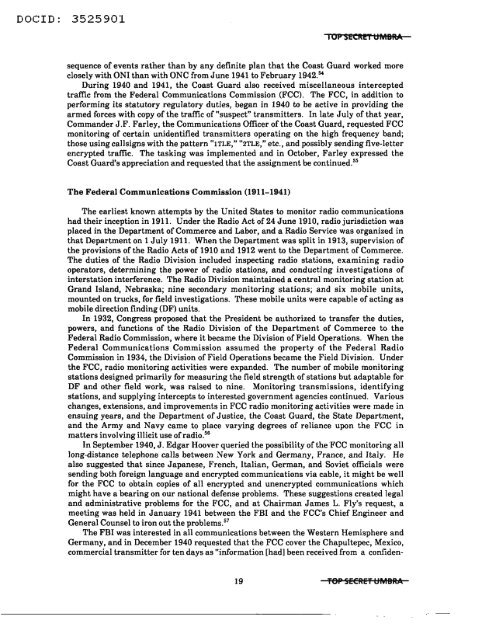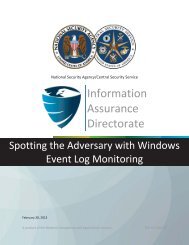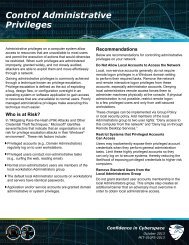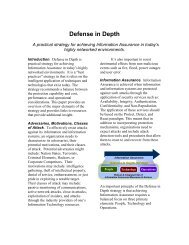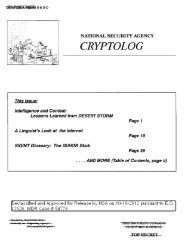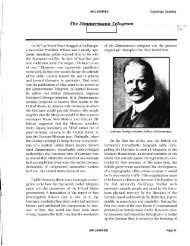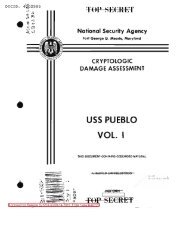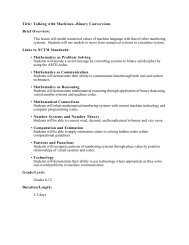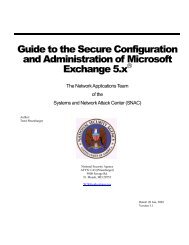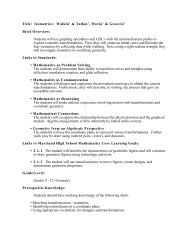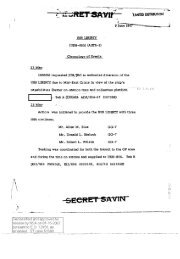German Clandestine Activities in South America in World War II
German Clandestine Activities in South America in World War II
German Clandestine Activities in South America in World War II
Create successful ePaper yourself
Turn your PDF publications into a flip-book with our unique Google optimized e-Paper software.
DOCID: 3525901<br />
10f SEeR!' tJMBIbIc:<br />
sequence of events rather than by any def<strong>in</strong>ite plan that the Coast Guard worked more<br />
closely with ONI than with ONC from June 1941 to February 1942. 54<br />
Dur<strong>in</strong>g 1940 and 1941, the Coast Guard also received miscellaneous <strong>in</strong>tercepted<br />
traffic from the Federal Communications Commission (FCC). The FCC, <strong>in</strong> addition to<br />
perform<strong>in</strong>g its statutory regulatory duties, began <strong>in</strong> 1940 to be active <strong>in</strong> provid<strong>in</strong>g the<br />
armed forces with copy of the traffic of"suspect" transmitters. In late July of that year,<br />
Commander J.F. Farley, the Communications Officer ofthe Coast Guard, requested FCC<br />
monitor<strong>in</strong>g of certa<strong>in</strong> unidentified transmitters operat<strong>in</strong>g on the high frequency band;<br />
those us<strong>in</strong>g callsigns with the pattern "lTLE," "2TLE," etc., and possibly send<strong>in</strong>g five-letter<br />
encrypted traffic. The task<strong>in</strong>g was implemented and <strong>in</strong> October, Farley expressed the<br />
Coast Guard's appreciation and requested that the assignment be cont<strong>in</strong>ued.55<br />
The Federal Communications Commission (1911-1941)<br />
The earliest known attempts by the United States to monitor radio communications<br />
had their <strong>in</strong>ception <strong>in</strong> 1911. Under the Radio Act of 24 June 1910, radio jurisdiction was<br />
placed <strong>in</strong> the Department ofCommerce and Labor, and a Radio Service was organized <strong>in</strong><br />
that Department on 1 July 1911. When the Department was split <strong>in</strong> 1913, supervision of<br />
the provisions of the Radio Acts of 1910 and 1912 went to the Department of Commerce.<br />
The duties of the Radio Division <strong>in</strong>cluded <strong>in</strong>spect<strong>in</strong>g radio stations, exam<strong>in</strong><strong>in</strong>g radio<br />
operators, determ<strong>in</strong><strong>in</strong>g the power of radio stations, and conduct<strong>in</strong>g <strong>in</strong>vestigations of<br />
<strong>in</strong>terstation <strong>in</strong>terference. The Radio Division ma<strong>in</strong>ta<strong>in</strong>ed a central monitor<strong>in</strong>g station at<br />
Grand Island, Nebraska; n<strong>in</strong>e secondary monitor<strong>in</strong>g stations; and six mobile units,<br />
mounted on trucks, for field <strong>in</strong>vestigations. These mobile units were capable of act<strong>in</strong>g as<br />
mobile direction f<strong>in</strong>d<strong>in</strong>g (DF) units.<br />
In 1932, Congress proposed that the President be authorized to transfer the duties,<br />
powers, and functions of the Radio Division of the Department of Commerce to the<br />
Federal Radio Commission, where it became the Division of Field Operations. When the<br />
Federal Communications Commission assumed the property of the Federal Radio<br />
Commission <strong>in</strong> 1934, the Division of Field Operations became the Field Division. Under<br />
the FCC, radio monitor<strong>in</strong>g activities were expanded. The number of mobile monitor<strong>in</strong>g<br />
stations designed primarily for measur<strong>in</strong>g the field strength of stations but adaptable for<br />
DF and other field work, was raised to n<strong>in</strong>e. Monitor<strong>in</strong>g transmissions, identify<strong>in</strong>g<br />
stations, and supply<strong>in</strong>g <strong>in</strong>tercepts to <strong>in</strong>terested government agencies cont<strong>in</strong>ued. Various<br />
changes, extensions, and improvements <strong>in</strong> FCC radio monitor<strong>in</strong>g activities were made <strong>in</strong><br />
ensu<strong>in</strong>g years, and the Department of Justice, the Coast Guard, the State Department,<br />
and the Army and Navy came to place vary<strong>in</strong>g degrees of reliance upon the FCC <strong>in</strong><br />
matters <strong>in</strong>volv<strong>in</strong>g illicit use ofradio.56<br />
In September 1940, J. Edgar Hoover queried the possibility ofthe FCC monitor<strong>in</strong>g all<br />
long-distance telephone calls between New York and <strong>German</strong>y, France, and Italy. He<br />
also suggested that s<strong>in</strong>ce Japanese, French, Italian, <strong>German</strong>, and Soviet officials were<br />
send<strong>in</strong>g both foreign language and encrypted communications via cable, it might be well<br />
for the FCC to obta<strong>in</strong> copies of all encrypted and unencrypted communications which<br />
might have a bear<strong>in</strong>g on our national defense problems. These suggestions created legal<br />
and adm<strong>in</strong>istrative problems for the FCC, and at Chairman James L. Fly's request, a<br />
meet<strong>in</strong>g was held <strong>in</strong> January 1941 between the FBI and the FCC's Chief Eng<strong>in</strong>eer and<br />
General Counsel to iron out the problems.57<br />
The FBI was <strong>in</strong>terested <strong>in</strong> all communications between the Western Hemisphere and<br />
<strong>German</strong>y, and <strong>in</strong> December 1940 requested that the FCC cover the Chapultepec, Mexico,<br />
commercial transmitter for ten days as "<strong>in</strong>formation [had] been received from a confiden-<br />
19 Tap SECRET t:JMBRl!c


